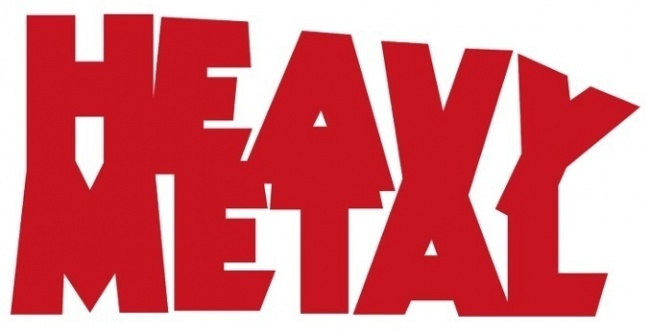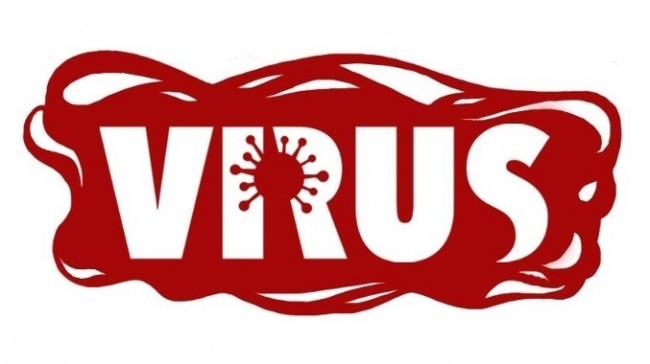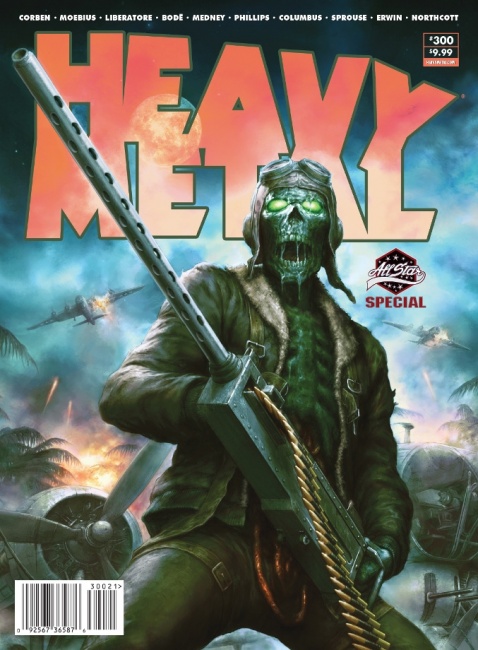We caught up with Heavy Metal CEO Matthew Medney and Publisher David Erwin (see "Heavy Metal Appoints New Publisher"), who took over last fall, to talk about their publishing plans for the magazine, comics, and their new VIRUS imprint.
ICv2: What's been going on since the management change? Is the magazine coming out?
Matt Medney: Yes, the magazine comes out every other month right now. We had #297 come out in January, #298 come out in March. Unfortunately, because of COVID, our #299 got pushed to June, and then our 300th will come out in August (see "Preview: 'Heavy Metal' #300"). After #300, and moving forward, we'll be a monthly magazine.
Was there a gap in publication before the new management team took over?
David Erwin: It was erratic. There was no consistency with how often they released the issue; it was whenever they got it done. One year it may have been five issues. Another year it may have been seven, so one of the things that we've had to do is rebuild the confidence within the retailers that you can depend on Heavy Metal delivering on a regular basis.
We now have a rhythm in place. We have a staff that has been working diligently and doing an amazing job, so we can, again, get the consumers, the readers, and our fans to expect to see these magazines month after month.
Have you also been publishing comics before the launch of the VIRUS imprint?
Medney: The previous management team did release the fourth issue of Taarna, and that was all, and then there was release of the trade paperback. The trade paperback that collected four Taarna issues came out just before we came on board.
We are going to be releasing our own Heavy Metal branded comic books, because what we really want to do is make sure that we're constantly in the front of mind of our readers. One magazine a month, even though we're upping it to once a month, isn’t really a strong enough presence in the comic shop. By releasing our own properties and monthly, we hope to be able get to a place where every week you can expect a Heavy Metal title on the shelf somewhere.
There's going to be Heavy Metal brand comics and VIRUS brand comics?
Erwin: That's correct. Some of the Heavy Metal branded comics are everything from the relaunch of Taarna to [longtime Heavy Metal character] Nelson's comic series, which is called Cold Dead War, which we have George Romero Jr. writing. Then we have a slew of other things coming out, from the likes of Bart Sears. Ron Marz, and Steve Orlando.
The VIRUS books will be its own imprint and animal, in addition to those.
For your magazine and for your upcoming comics, is Diamond your sole distribution there? Do you have any bookstore distribution or anything like that for the magazine?
Medney: For the books, Diamond brings them all to the comic book shop. For the magazines, it's split between Diamond and TNG for our Books‑A‑Million, Barnes & Nobles, and all of the other newsstand opportunities on the magazine side.
In addition to all those, we do direct‑to‑consumer on our online shop, which is printed materials bought from our e‑commerce store. Those are our three pillars.
Let's talk about VIRUS specifically. You already have a comic publishing operation, so why are you launching VIRUS as a new initiative?
Erwin: That came out of the recent COVID and sheltering in. When the Diamond distribution came to a standstill and comic shops were having to shutter their doors, we weren't sure, nobody knew, when Diamond was going to start operations again.
Ever since the inception back in 1977, Heavy Metal has been publishing works from creators and talents from all over the world. When we came on board, the solicitation of all of these submissions of amazing stories continued to come in to our Dropbox. Even now that we're going into a monthly publication, still there's not enough pages for the things that we'd like to publish.
There's such a wealth of great content that we have access to, and we felt that, since we don't know what's going to happen after life gets back to semi‑normal, how the publishing business is going to be, we felt that VIRUS was a way of being able to continue to offer content to our fans and to the comic book reader. That's how we came up with the idea of VIRUS and the means to do it.
One of the things that Matt has done brilliantly was to get us a printer early on to look at all of our costs. One of them was looking at, "Can we do a better job with our printing? Can we bring the cost down of the printer?"
When Matt was considering moving our printing from offset into digital, I was skeptical until he shared with me actual comics that he had published from his other company, Hero. I had no idea that these were not offset printed. They're beautifully printed books.
Medney: The big difference between offset and digital printing is that typically offset runs on a 16‑color palette and digitals run on 8. That's why you usually see a difference, digital to offset; however, our printers have state‑of‑the‑art digital printers that run off of a 16‑color palette, same as an offset, so the quality stays the same while the flexibility in numbers of printing is more malleable.
Erwin: We have fulfillment, because Heavy Metal magazine has always had a business on the subscription side, so we have an infrastructure already there. Since we had the fulfillment, and now we had the means to be able to print 1 copy or 20,000 copies, then we got the idea, "You know what? Let's see what we can do about all of this content that people who are offering it to us and want to publish it. Why don't we create an imprint where we can take things that we feel live up to the Heavy Metal standard and print it under VIRUS?"
What's the differentiation between the Heavy Metal brand and the VIRUS brand?
Erwin: The Heavy Metal brand is known as the leading publisher of science fiction, fantasy, and horror. It has been since inception, and it's been one of the most influential magazines since. We are making efforts to make sure that we uphold to that legacy on the Heavy Metal brand, so we scrutinize much more.
In addition to that, a lot of the content that comes to us is way too long for us to publish over a period of time. We do serialize some of the stories that may carry for 12 months, or 10 issues, or however many issues, but we can only carry so much of that.
That's why we felt that VIRUS has been a great way to resolve that and share a lot of different voices from all over the world that we normally wouldn't have an opportunity to.
Medney: I would add to that, in addition to everything David said, VIRUS' deal is also very different. When something's a Heavy Metal comic or in the magazine, Heavy Metal obviously owns some, most, or all of it. All VIRUS books are creator‑owned.
In addition to having books where we want press up a young or new creator, something that's in the vein and we really want to show, there's also big creators, like a Bob Fingerman, who's releasing via VIRUS because he wants to keep his ownership.
We love Bob. We've published him in the magazine, and we've licensed stuff there. He wanted to have a similar experience on his graphic novel, so it made sense for that to be a VIRUS book because all VIRUS books are also creator‑owned.
So beyond the creator-owned aspect, I assume on your Heavy Metal magazine or comic content you've got some kind of advance or guarantee. It sounds like the VIRUS imprint is straight royalty. Would those be the main differences for the creator?
Erwin: Yes.
How do retailers fit into the picture for VIRUS?
Erwin: At first, when we first initiated this and launched it, we were really only thinking about the reader and making sure that we can continue to provide readers with content. It didn't take long before we had retailers knocking on our door and starting to ask if they can start carrying VIRUS.
Medney: With VIRUS, we're going to be starting to distribute via Diamond into comic book stores in October. After talking to Diamond and talking to some of our retailers that we have direct relationships with, that felt like the right time frame to introduce a bunch of new IP. We'll be bringing to the stores the best VIRUS books, so not necessarily all of them.
What's great about VIRUS is we have a lot of awesome data on our side from the online sales. David and I review that on a biweekly basis. As we start getting into solicitations for October and on, we'll be picking one VIRUS book to be released a week that we see the sales are strong and that we know retailers will be able to create a revenue stream for.
One of the biggest things that David and I are focused on with Heavy Metal, with VIRUS, with everything, is you have to create a model that everybody wins with or it falls apart at some point, where the bill is always due if you do not create a model that allows your retailers to make money, you to make money, and your creators to make money, and that's what VIRUS allows.
Being that the books are released on our online store first allows us to get great data so that when we bring them to the stores we can be confident in telling them that we know those books will move in their specific market.
What's going out through Diamond from the VIRUS brand will be a subset of the total output?
Erwin: Correct. It will be the best sellers because, again, we don't want to flood the retailers with titles that nobody is familiar with and they're unfamiliar with. We've seen time and time again with other publishers, and established publishers, they put their money down on titles that don't perform. At least it has a better chance of having a sell‑through if we are providing the data prior to soliciting retailers.
What are you expecting as far as your monthly output of VIRUS titles? You said you're going to start in October, so you're going to launch with one a week or one a month? How many are you going to put out?
Medney: Right now, we release two VIRUS titles a week on our online store. That gets delivered to our newsletter base; about 60,000 people get a digital storefront VIRUS store newsletter every Wednesday.
We've put out two new books every week. Starting in October, when we go in‑shop, we will be doing one a week for the foreseeable future. As David was saying and as I was saying earlier, we won't be forcing it in. If we don't have a book that feels like it's the right fit for a store, we'll miss a week.
Right now we have a bunch of books that we feel confident about distributing to stores and being something that everybody can create value from, so we believe that we'll be able to do one a week starting in October.
What's the format of the VIRUS books going to be for retailers? Will that be the same as the one that you're doing for direct-to-consumer?
Medney: We have single issues. We have trades. We have one‑shots.
Sometimes, if we put out a four‑issue floppy and then collect into a trade, maybe we only do the trade in‑store. We obviously know retailers like the higher‑priced items. It's a better business for everybody. If we know a story has a fan base and we can bring the trade out, that's definitely something that we're going to look at and see if that makes sense economically.
In terms of what the format is, VIRUS books range from five issues, to collected, to graphic novels, to one‑shots that are 48 pages, and everything in between.
Are you using this digital printing for your regular comics, too?
Medney: Yes.
You're able to do shorter runs, and that's why it's a good fit for VIRUS, too?
Medney: The whole thing with VIRUS and how we can pay creators 15 percent, from the first book sold, on every book sold is because we're able to do print runs that are malleable with the demand.
Whatever that print run is, whether it's VIRUS, whether it's Heavy Metal, it's a better model in general. It's leading into the future of how things should be done. That's smarter business.
Instead of paying for 20,000 books to sit in a warehouse and work on getting those sold, we can do print runs of 5,000, of 2,000, of 1,500, etc., etc., depending on demand, without cutting into our margins, which allows us to pay creators from the start, as well as allows us to project better with inventory.
Because the big thing that a lot of people don't necessarily account for always is the soft costs that mount. When you do high print runs at the cheapest possible rate, you don't necessarily include in the warehousing fees when the books don't sell.
What we're able to do is have that same high quality of printing, the same high quality product that anybody else in the market has, but we're able to do print runs that are very focused into what we know the direct demand is, so we don't have any fat. We're just bringing meat to everybody.
Anything else you want retailers to know about the VIRUS program or the overall Heavy Metal publishing program?
Erwin: I would like to clarify a little bit more the distinction between Heavy Metal and VIRUS. What we publish in Heavy Metal, whether it's in the magazine or the comic book, are various properties that we own or we share, whereas VIRUS is completely a creator‑owned publishing imprint. Meaning that if you publish through VIRUS, it's like Image comics books. All the Image titles are creator‑owned. The difference between us and someone like Image is at Image you have to lay out cash. Even after you've completed your content and you did all your production, you still have to lay out cash, and the creator never receives any check until all of the money has been recouped by Image.
Here, from the first copy on, the creator gets a check. It's more having advantageous to be able to publish through our model than it is through other publishers. As Matt was talking about is that it's advantageous for everybody, because then everybody gets a piece of it, and everybody gets a piece of it from the first copy out.

As They Launch VIRUS
Posted by Milton Griepp on June 4, 2020 @ 5:48 am CT







